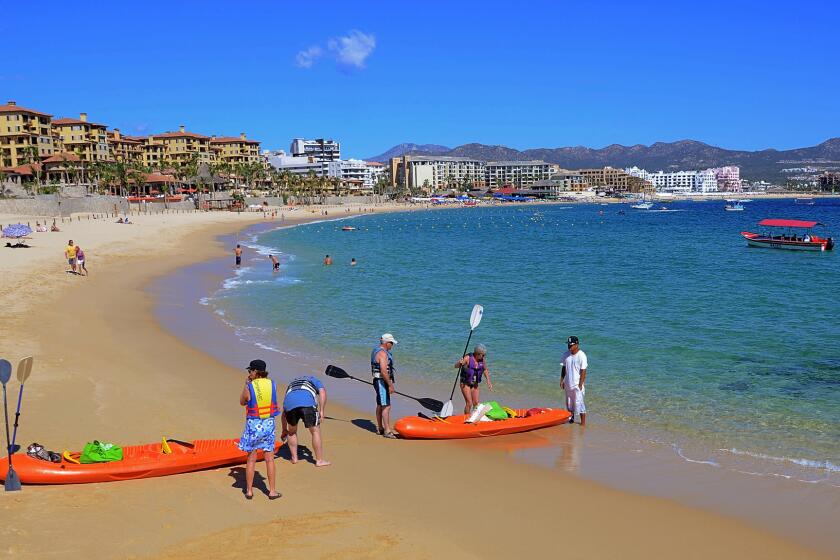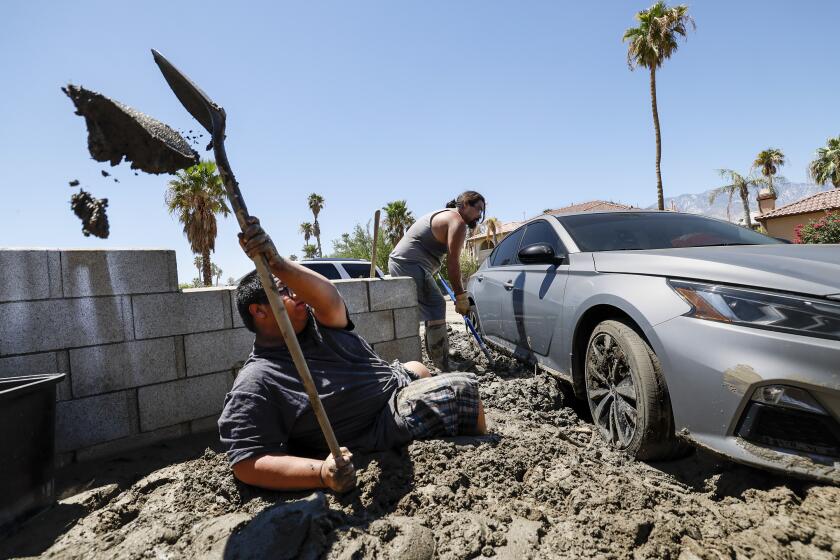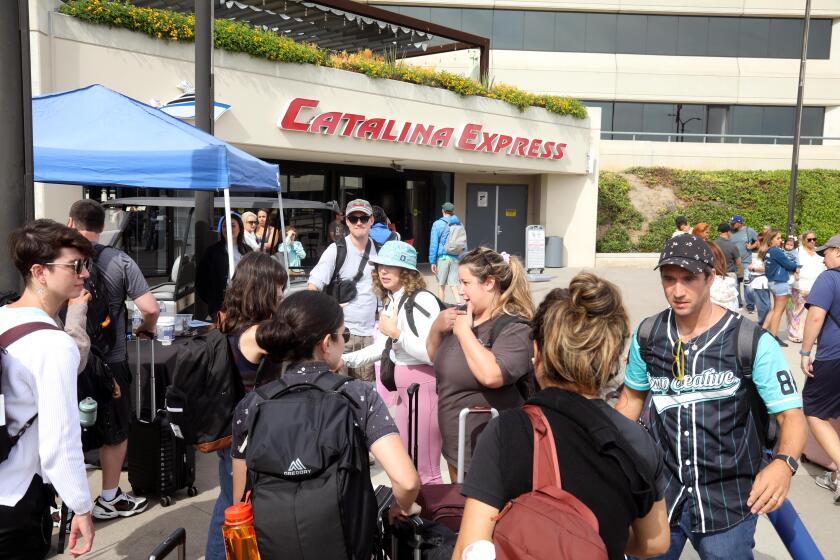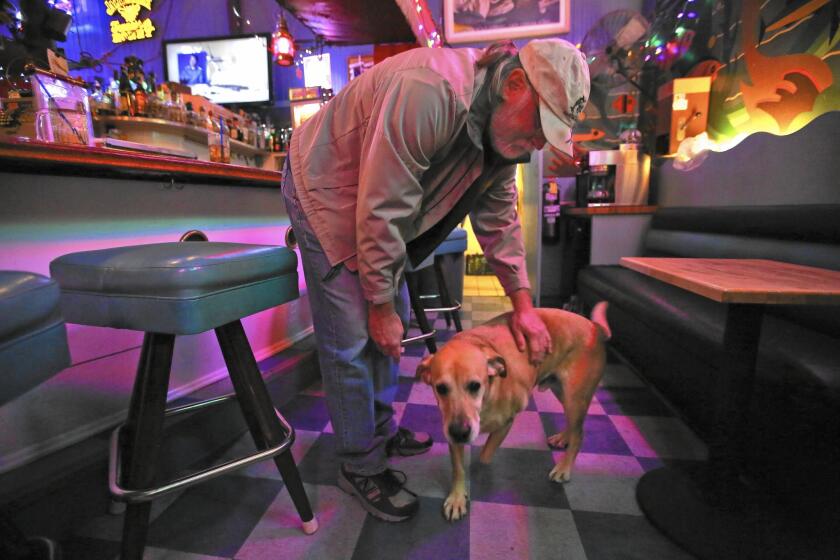Catalina got a scary Hilary warning. But the island was prepared
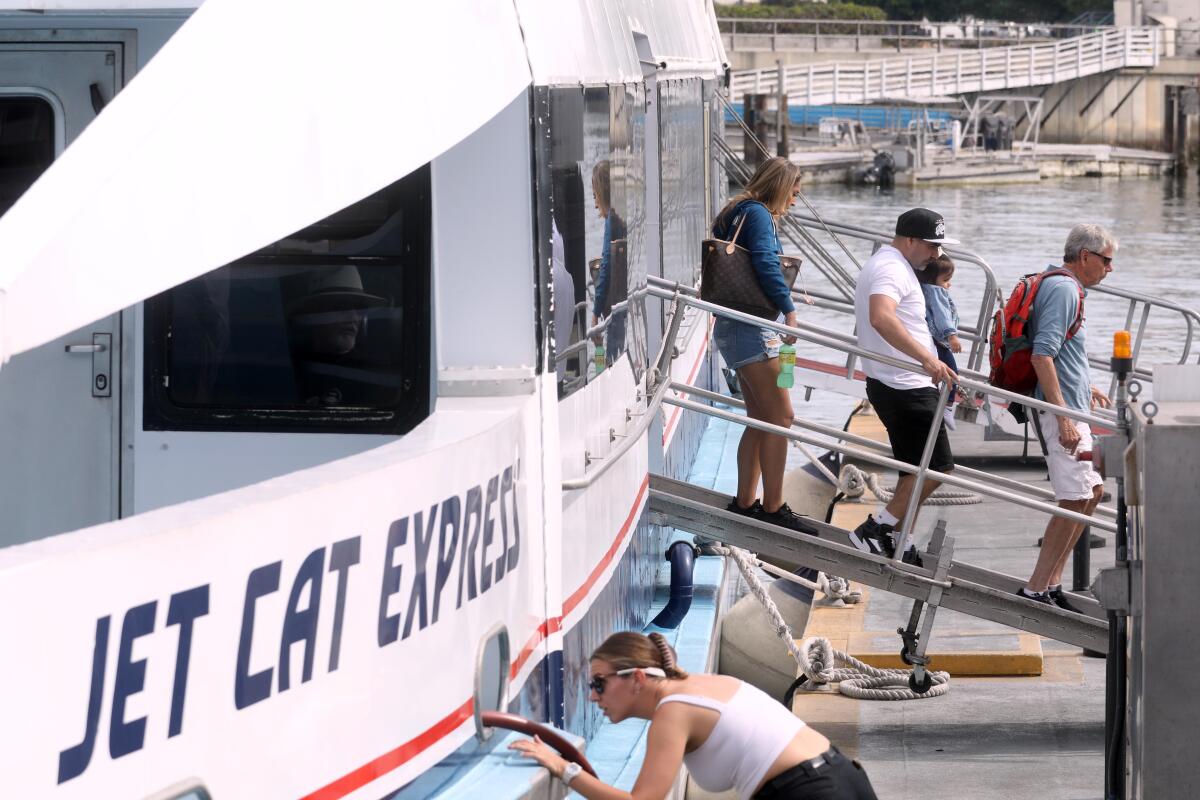
- Share via
The warning sounded around 10 a.m. Saturday — a shrill cellphone chime advising thousand of residents and visitors to evacuate Santa Catalina Island ahead of Tropical Storm Hilary’s anticipated arrival.
“Due to a forecast of storm impacts and possibly prolonged utility outages, Catalina Island residents and visitors, especially those with medical, access and functional needs, are advised to leave the island on August 19,” read the advisory from the Los Angeles County Sheriff’s Department. “Departure via Catalina Express is recommended at your earliest opportunity.”
The ominous message prompted questions: How many people would actually heed it? And was the island ready for such an urgent mass exodus?
In the end, the storm that dumped record rainfall totals and swamped communities across Southern California, especially in the desert, left the renowned tourist destination unscathed.
Thousands of tourists left Catalina by Sunday afternoon on Catalina Express boats for the 20-plus-mile crossing to the mainland. But most residents stayed put, with some recalling that a September storm — moisture from Tropical Storm Kay, situated off the Mexican coast — was far more damaging, flooding seaside businesses with saltwater.
“All weekend, the narrative was, ‘Oh, we haven’t seen one in 84 years or whatever,’ and I’m like, ‘No, we haven’t seen one in” 11 months, said Avalon City Manager David Maistros. “Not that we’re used to it, or immune to it, it’s just, we get it. It can happen out here, and it’s dangerous. And all you can do is prepare. You know, there’s preparation, and there’s avoiding panic, and I think that’s what we did a good job of this weekend.”
Maistros said he communicated all weekend with the National Weather Service, ship captains and county officials to ensure that Catalina, one of the eight Channel Islands, and its roughly 3,500 permanent residents and thousands more visitors were safe.
Had the path and fervor of the storm have changed dramatically, Maistros said emergency officials were confident everyone could have gotten off the island.
“We felt good going into the weekend,” he said. “If we had to do that, we could do that.”
Scientists have just revealed the climate forecast for the year 2080 in hundreds of cities across North America, and — surprise!
Greg Bombard, president and chief executive of Catalina Express, said his fleet of four catamarans and four monohull boats moved 3,650 people — primarily visitors — off the island Saturday, and took about 600 more Sunday.
By 1 p.m. Sunday, the last boat had only 36 passengers, a signal that they’d successfully gotten everyone who wanted to leave off the island before conditions were expected to worsen, he said.
Between his eight vessels, and his workforce of more than 300 people, it’s an operation that gets people off the island quickly should disaster strike, Bombard said. In 2007, when a large fire threatened Catalina, his company moved about 5,000 in one night.
“If we have an emergency, believe me, we’re all here,” said Bombard, whose family has had a presence on the island for the past 100 years.
After days of urgent warnings, Tropical Storm Hilary made landfall in Baja California on Sunday, turning roads into rivers and imperiling homes before barreling north toward Southern California.
Maeve Tracy, a 23-year-old hotel worker, said that by Sunday night there were only four guests staying in the Hermosa Hotel. Everybody checked out early Monday.
“Everybody outside of the island was more freaked out, but since we could see everything changing over here, I feel like we were all pretty calm about it,” said Tracy, who is originally from Chicago.
The county Office of Emergency Management and the Sheriff’s Department said had an evacuation order been called for, they believed all residents could have been taken off the island within six hours.
“This time estimate does not include the use of other ferry companies, helicopters, private boats, the U.S. Coast Guard, and U.S. Navy, which could dramatically shorten the time needed to evacuate the island,” the departments said in a written response to questions from The Times.
Fiete Krutein, a former University of Washington professor who co-authored a paper on evacuating isolated islands, said one of the most important steps local governments can take to ensure everyone gets off an island when a hurricane hits is to have an evacuation plan in place.
“We’ve just had a major fire disaster in Hawaii, and now this,” he said. “It really shows that having a plan in place is really going to help you in knowing what to do and how to respond.”
The L.A. County Sheriff’s Department recommended Saturday that tourists and residents, especially those with medical conditions, leave Catalina Island. Hurricane Hilary could bring intense rain and winds, knocking out power to the island.
Asked about the emergency preparedness plan for the Catalina Islands, the county departments said there were “numerous” emergency preparedness plans for the area. They added that the city of Avalon was working on obtaining grant money to create a “comprehensive emergency procedure manual.”
Maistros, the Avalon city manager, said island officials had taken other steps to ensure residents’ safety during the storm, outside of the evacuation advisory.
At the start of the weekend, harbor and city crews vacated harbors, telling pleasure boaters to head to their home harbors. Boats that couldn’t leave were brought into the harbor and attached to moorings to secure their crafts during the storm.
On Saturday morning, Southern California Edison brought 75,000 pounds of prefilled sandbags to fortify its power plant, which sits next to the shoreline. Edison provides electricity, gas and water to the island — only 12% of which is lived on by people, the other 88% under a conservation easement that prohibits development.
By Saturday afternoon, workers had completed the job and placed extra sandbags in Avalon for businesses and residents to grab.
There were also comfort stations with generators ready at Avalon City Hall, the high school gym and Tremont Hall, a community gathering center, where residents could have charged their phones and laptops if the island had lost power.
The decision to issue the evacuation advisory, Maistros said, was made out of an “overabundance of caution” — potentially influenced in part by the catastrophic decisions made by emergency officials in Maui. With so many lives lost there, he said, officials may have felt they were “better safe than sorry.”
Many residents on Catalina have family and friends on Maui, he said.
“It’s a connection a lot of people don’t recognize, but there’s a strong sense of community with Maui,” he said. “So that was on [the] forefront of everyone’s mind.”
Some Catalina residents who decided to stay put said in interviews Monday that they remembered a brutal storm in late 2014 that killed two beloved members of the islands seafaring community, and took action to protect themselves.
Bob Beetley, 79, spent the storm at a hotel on the island after docking his boat Onahi, where he’s lived for five months out of the year for over three decades, splitting time between the boat and his home in Malibu.
Beetley said before the storm hit, owners rushed to moor their boats, remembering how a storm in 2014 killed Avalon residents Bruce Ryder and Harbor Patrol Officer Timothy Douglas Mitchell.
As the wind howled outside the Marlin Club that night, Pretty Boy darted inside.
That taught Beetley that it truly wasn’t worth it to try to stay on your boat and ride out the storm.
“The sheriffs were right on top of everything,“ he said. “We were hoping that they were overshooting which it ended up being, which is OK with me.”
On Monday, dozens of white, green and orange sandbags sat next to several of the businesses lining Crescent Avenue, a pedestrian walkway that runs parallel to the shore. Some businesses remained closed, but many were open to the small crowd of tourists who remained or trickled back in on ferries Monday.
Howie Lee and his wife, Sam Leng, arrived on the island Monday for a three-day vacation.
After a stressful weekend monitoring storm conditions, they were now reaping the benefits of a post-storm Catalina: a touristless island.
“Everything stayed open,” Lee said. “Just a little slower than anticipated.”
More to Read
Sign up for Essential California
The most important California stories and recommendations in your inbox every morning.
You may occasionally receive promotional content from the Los Angeles Times.
